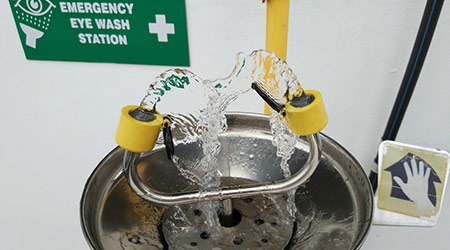Q: Is there a requirement to test eyewash stations annually? We do a weekly test for various items but are we required to conduct an annual test as well?
A: Yes… ANSI Z358.1-2014 section 5.5.5 says all eyewashes shall be inspected annually to assure conformance with Section 5.4 requirements of this standard.
Section 5.4 says it is the owner’s responsibility to ensure that eyewashes shall:
• Be assembled and installed in accordance with the manufacturer's instructions, including flushing fluid delivery requirements.
• Be in accessible locations that require no more than 10 seconds to reach. The eyewash shall be located on the same level as the hazard and the path of travel shall be free of obstructions that may inhibit its immediate use.
• Be located in an area identified with a highly visible sign positioned so the sign shall be visible within the area served by the eyewash. The area around the eyewash shall be well-lit.
• Be arranged such that the flushing fluid flow pattern as described in Section 5.1.8 is not less than 33 inches and no greater than 53 inches from the surface on which the user stands and 6 inches minimum from the wall or the nearest obstruction.
• Be connected to a supply of flushing fluid per the manufacturer’s installation instructions to produce the required spray pattern for a minimum period of 15 minutes. Where the possibility of freezing conditions exists, the eyewash shall be protected from freezing or freeze-protected equipment shall be installed. If shut off valves are installed in the supply line for maintenance purposes, provisions shall be made to prevent unauthorized shut off.
• Deliver tepid flushing fluid. In circumstances where chemical reaction is accelerated by flushing fluid temperature, a facilities safety/health advisor should be consulted for the optimum temperature for each application.
• When the plumbed eyewash is installed, its performance shall be verified in accordance with the following procedures:
• • With the unit correctly connected to the flushing fluid source and the valve(s) closed, visually check the piping connections for leaks.
• • Open the valve to the full open position. The valve shall remain open without requiring further use of the operator's hands.
• • With the valve in the fully open position, make sure that both eyes will be washed simultaneously at a velocity low enough to be non-injurious to the user.
• • Using the flowmeter or other means, determine that the rate of flow is at least 0.4 gpm.
• • Using a temperature gauge or other means, determine that the flushing fluid is tepid.
• When the self-contained eyewash is installed, its installation shall be verified in accordance with manufacturer’s instructions.
Brad Keyes, CHSP, is the owner of KEYES Life Safety Compliance, and his expertise is in the management of the Life Safety Program, including the Environment of Care and Emergency Management programs.

 How Efficiency Checklists Help Hospitals Save Energy, Water and Money
How Efficiency Checklists Help Hospitals Save Energy, Water and Money Designing with Heart: Seen Health Center Blends Cultural Warmth and Clinical Care
Designing with Heart: Seen Health Center Blends Cultural Warmth and Clinical Care Rutgers Health and University Hospital Breaks Ground on Campus Expansion
Rutgers Health and University Hospital Breaks Ground on Campus Expansion What to Consider When Modernizing Healthcare Facilities
What to Consider When Modernizing Healthcare Facilities Corewell Health Beaumont Troy Hospital to Build New Tower
Corewell Health Beaumont Troy Hospital to Build New Tower